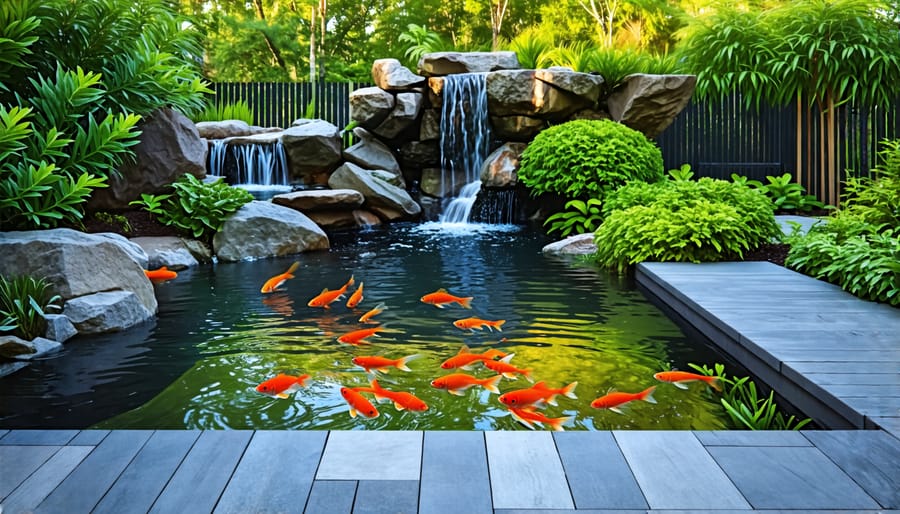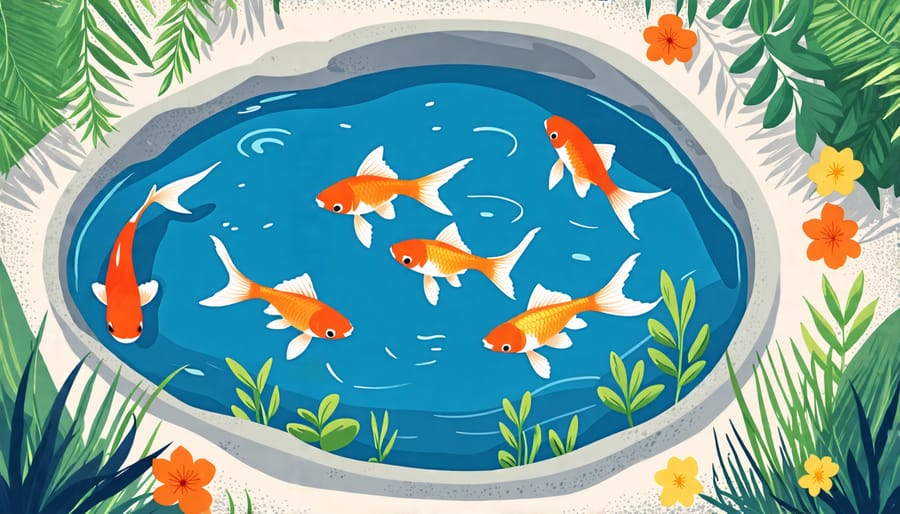
Create a Thriving Goldfish Breeding Paradise in Your Backyard
Select a sunny location with a natural clay base to create a thriving goldfish breeding pond. Transform your backyard by excavating a shallow pond with gently sloping sides, ensuring a depth of at least 3 feet to protect fish from extreme temperatures. Establish aquatic plants like hornwort and water lilies to provide hiding spots for fry and maintain water quality. Introduce a balanced mix of healthy adult goldfish, maintaining a ratio of one male to two females for optimal breeding conditions.
Choosing the Perfect Location

Sunlight and Shade Requirements
When designing your goldfish breeding pond, it’s crucial to consider the balance between sunlight and shade. Goldfish thrive in environments with a mix of both, as it promotes healthy growth and reduces stress. Aim for a location that receives about 4-6 hours of direct sunlight per day, preferably during the morning hours. This exposure encourages the growth of beneficial algae, which serves as a natural food source for your fish. However, too much direct sunlight can lead to overheating and excessive algae growth, which can negatively impact water quality. To prevent this, incorporate shaded areas using floating plants, such as water lilies or lotus, or by planting tall aquatic vegetation along the pond’s edges. These natural shade sources not only regulate water temperature but also provide shelter for your goldfish, reducing their stress levels and promoting a sense of security. Strike the right balance, and your goldfish will flourish in their well-designed breeding environment.
Proximity to Home and Utilities
When selecting a location for your goldfish breeding pond, proximity to home and utilities is a crucial factor to consider. Having your pond close to a water source, such as a garden hose or outdoor faucet, makes it convenient to fill the pond initially and top it off as needed. This proximity also simplifies routine maintenance tasks like water changes and cleaning. Access to electricity near the pond is equally important, as it enables you to power essential equipment such as pond pumps, filters, and aerators. These devices help maintain optimal water quality and oxygenation, which are vital for the health and growth of your goldfish. Additionally, having your pond within easy reach of your home allows for frequent monitoring and quick response to any issues that may arise. By situating your goldfish breeding pond near these utilities, you can ensure a more efficient and enjoyable pond management experience.

Designing Your Goldfish Breeding Pond
Pond Size and Depth
When planning your goldfish breeding pond, size and depth are crucial factors to consider. A larger pond provides more space for your fish to grow, swim, and reproduce comfortably. As a general rule, aim for a minimum of 50 gallons of water per adult goldfish. For breeding purposes, a pond with a surface area of at least 100 square feet and a depth of 3 to 4 feet is ideal.
Deeper ponds offer several advantages, such as more stable water temperatures, better protection from predators, and improved overwintering capabilities. However, if you live in a warmer climate, a shallower pond around 2 feet deep can suffice. Keep in mind that shallower ponds may require additional measures to prevent overheating during summer months.
When determining the perfect size for your breeding pond, consider the number of goldfish you plan to keep and their expected growth rate. It’s better to err on the side of a larger pond, as it provides a more stable environment and allows for future expansion of your goldfish population.
Lastly, don’t forget to account for the space needed for filtration systems, plants, and any decorative elements you wish to include. By carefully planning your pond’s dimensions, you’ll create an optimal environment for your goldfish to thrive and reproduce successfully.
Filtration and Aeration Systems
Maintaining excellent water quality and oxygenation is crucial for the health and vitality of your goldfish in the breeding pond. A well-designed filtration system is essential to remove waste, debris, and harmful toxins from the water. Consider installing a combination of mechanical and biological filters, such as skimmers, settlement chambers, and filter mats, to effectively capture solid particles and promote the growth of beneficial bacteria that break down pollutants.
To further enhance water quality, harness the power of natural filtration by incorporating aquatic plants like water lilies, hornwort, and water lettuce. These plants not only add aesthetic appeal to your pond but also absorb excess nutrients and provide shelter for goldfish fry.
Proper aeration is equally important to maintain optimal oxygen levels in the water. Install air pumps or fountains to create surface agitation and promote gas exchange. This will help prevent stagnant water and ensure your goldfish have access to well-oxygenated water throughout the pond.
Regular monitoring of water parameters, such as pH, ammonia, nitrite, and nitrate levels, is essential to detect any imbalances early on. Perform partial water changes as needed to maintain a healthy environment for your goldfish to thrive and reproduce successfully.
Aquatic Plants and Landscaping
Elevate your goldfish breeding pond by incorporating aquatic plants and thoughtful landscaping. Aquatic plants not only enhance the visual appeal but also contribute to a balanced ecosystem. Consider floating plants like water lettuce or water hyacinth, which provide shade and absorb excess nutrients. Submerged plants such as hornwort and anacharis oxygenate the water and offer hiding spots for fry. Marginal plants, including irises and rushes, add texture and beauty to the pond’s edges. When landscaping around the pond, opt for a natural look with rocks, gravel, and low-maintenance vegetation. Create a seamless transition between the pond and its surroundings for a cohesive and captivating outdoor space.
Stocking Your Pond with Goldfish
Choosing Healthy Breeding Stock
When selecting goldfish for your breeding pond, prioritize health and desirable traits. Look for fish with vibrant colors, well-proportioned bodies, and no signs of disease or deformities. Avoid fish with protruding eyes, bent spines, or abnormal scales. Opt for active swimmers with clear eyes and smooth, intact fins.
Consider the specific variety you want to breed and choose individuals that exemplify the ideal characteristics of that strain. For example, if breeding fantails, select fish with well-developed, symmetrical double tails and an egg-shaped body.
To ensure the health of your founding stock, purchase from reputable breeders or suppliers who maintain high standards of care. Quarantine new fish for at least two weeks before introducing them to your pond to prevent the spread of potential diseases.
Genetics play a crucial role in the quality of offspring. Research the lineage of your chosen fish and aim for diverse, unrelated pairs to minimize inbreeding. This will help maintain the vigor and adaptability of future generations.
Lastly, age is an important factor. Select mature fish that have reached breeding age, typically around one to two years old, depending on the variety. Avoid using very old or overly young fish, as this can impact fertility and the health of the fry.

Acclimating Goldfish to the Pond
Acclimating your goldfish to their new pond environment is crucial for minimizing stress and ensuring a smooth transition. The key is to take it slow and steady. Begin by floating the fish in a sealed bag containing their original water for about 15-20 minutes, allowing the temperature to equalize. Gradually add small amounts of pond water to the bag every 5 minutes for the next 20-30 minutes. This process helps the fish adjust to any differences in pH, hardness, or other water parameters.
Once acclimated, gently release the goldfish into the pond. Avoid sudden movements or loud noises that may startle them. It’s best to introduce new fish during cooler parts of the day, such as early morning or evening, to reduce stress. Keep a close eye on your goldfish for the first few days, monitoring their behavior and appetite. Provide them with plenty of hiding spots, like submerged plants or decorations, to help them feel secure in their new home. With patience and care, your goldfish will soon be thriving in their beautiful backyard paradise.
Maintaining Your Goldfish Breeding Pond
Regular Water Changes and Testing
Regular water changes are essential for maintaining a healthy environment in your goldfish breeding pond. Aim to change about 10-20% of the water every week, using a pond vacuum or siphon to remove debris and waste from the bottom. When adding fresh water, ensure it is dechlorinated and temperature-matched to avoid shocking your fish.
Regularly test your pond water using a reliable test kit to monitor key water parameters such as pH, ammonia, nitrite, and nitrate levels. Ideal pH for goldfish should be between 7.0 and 8.4, with ammonia and nitrite levels at 0 ppm and nitrate below 40 ppm. If any parameters are off, take appropriate measures to correct them, such as performing additional water changes or adjusting your filtration system.
Keep an eye on water temperature as well, as goldfish thrive in temperatures between 65-75°F (18-24°C). Use a pond thermometer to monitor temperature fluctuations and consider using a pond heater or shade cloth to maintain stable conditions.
By staying on top of water quality through regular changes and testing, you’ll create a thriving environment for your goldfish to breed and flourish in their backyard pond paradise.
Feeding and Nutrition
Providing a balanced diet is crucial for the growth, coloration, and breeding success of your goldfish in the pond. A high-quality commercial goldfish food that contains a mix of proteins, carbohydrates, and essential vitamins and minerals should form the foundation of their diet. Supplement this with a variety of fresh live foods such as brine shrimp, daphnia, and bloodworms, which not only offer excellent nutrition but also stimulate the fish’s natural foraging instincts.
Regularly offer blanched vegetables like spinach, lettuce, and peas with the skin removed to provide additional fiber and nutrients. Avoid overfeeding, as excess food can lead to water quality issues and health problems for your fish. Feed your goldfish two to three times daily, only providing what they can consume within a few minutes.
During the breeding season, increase the frequency of high-protein live and frozen foods to support the development of healthy eggs and sperm. Maintaining proper nutrition will ensure your goldfish remain vibrant, active, and ready to spawn in their well-designed breeding pond.
Conclusion
Creating a thriving goldfish breeding pond is a rewarding experience that brings joy and beauty to your outdoor space. As you watch your goldfish flourish and multiply in their carefully designed habitat, you’ll feel a sense of pride and accomplishment. The vibrant colors and graceful movements of your goldfish will provide a tranquil and mesmerizing focal point in your garden, offering a peaceful retreat from the stresses of daily life. With proper care and attention, your goldfish breeding pond will become a self-sustaining ecosystem, teeming with life and delighting visitors of all ages. Embrace the wonders of nature and enjoy the fruits of your labor as you cultivate a thriving aquatic paradise in your own backyard.
